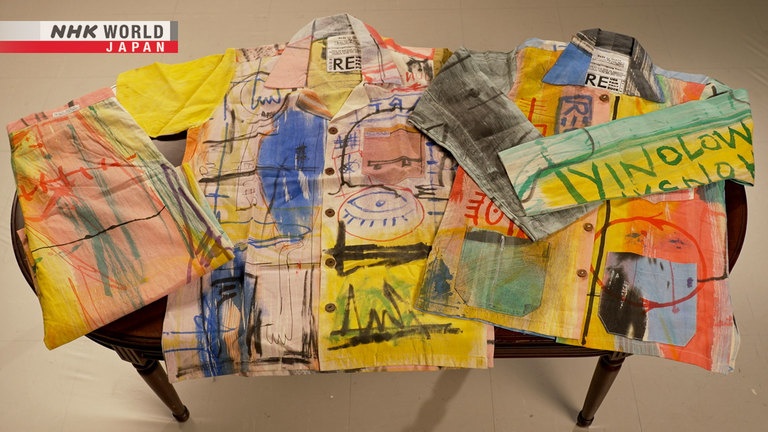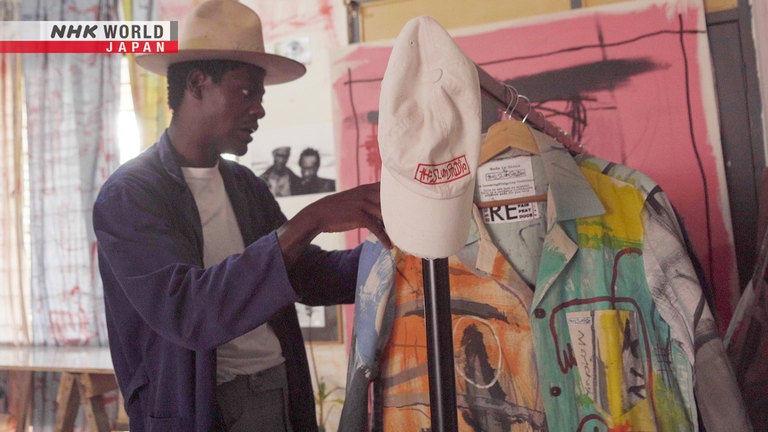Art To Create a Stir on Social Issues: Sel Kofiga / Artist
Much of the used clothing sent to Africa is discarded. A Ghanaian who conveys this reality through art talks about sustainable ways for the consumer society to address clothing.


Transcript
Direct Talk
Africa receives huge amounts of
secondhand clothes
from all over the world,
including Asia and the West.
However, many items
are discarded without
being passed on to consumers.
One man creates art based on the
used fabrics that enter his country, Ghana.
His name is Sel Kofiga.
Arts in itself
can be a door that opens
different possibilities
or making people think that
something can be possible.
Let's hear Sel's thoughts on
how to create a sustainable world.
Art to Create a Stir on Social Issues
I'm specifically interested in
the secondhand clothing.
How a material like the second clothing
has ended up in our space,
how a material like the second clothing has
moved from different parts of the world and
has found a presence home.
It is indeed creating
a lot of issues
environmentally,
you know, physically,
so many other issues.
It's a thing that keeps coming.
It keeps it is coming to this space.
So when it comes into this space and
some of them are being able to be used
for what is going to be used for,
the rest ends up somewhere
and they end up in landfills,
they end up in waterbodies,
they end up in different spaces where
they end up destroying what the ecological
viability of some of these spaces.
So for the issues is so many.
Developed countries send a large volume of
used clothing to less-developed countries
for resale or as donations.
Ghana is the leading recipient
of the clothing.
It receives around
15 million items every week.
However, because of an influx
of low-quality used clothes,
certain items have to be discarded,
and this has aggravated
the city's public health issues.
And there is another problem:
the availability of low-priced used clothing
can have an adverse market effect
on locally-produced clothes.
To help address these issues
and disseminate the current situation,
Sel launched an art project
named "The Slum Studio."
I try to follow conversations
around this material,
environmental wise and also financial wise.
So I look at the engagement between people,
how it is displayed, how it is sold,
how it is used,
and the kind of people who use it.
So I use these different stories
to build up what is "The Slum Studio."
Sel's activities are based in Accra,
Ghana's capital.
Okay. So welcome.
This is my space. This is The Slum Studio.
So this, here, is
some of the fabrics that I turned into,
the textiles that I make.
They are all used white, used bedsheets,
mostly cotton fabrics.
And here some of the clothes that I work on.
So this is the last collection that I did.
I also pick used clothes
and then I paint on them.
And this is one or the one
that I painted on very recently.
Sel makes various artworks,
including shirts, trousers, and hangings.
And when creating something,
he visits a market that has
a special meaning for Ghanaians.
Traditionally we also have open markets.
So historically they've been like spaces,
sacred spaces
that not just the physical,
the physical being
or the or people engage with
other spiritual beings
also engage with these spaces.
There is one very big space
or one very big market here in Ghana
called the Kantamanto market.
So I collect different fabrics
from this space.
I collect both textiles,
used textiles, used textiles.
The used textile that I'm interested in,
either used curtains or used bed sheets.
And there is also one clothes
that I'm interested in.
I also collect people's worn clothes
and I put these two things together.
Yeah, I try to play with the material
in a way that
ends up becoming part of the story
that I'm building.
On top of that,
Sel's works are characterized by
vivid colors of blue, pink, and yellow.
And he casually adds unique symbols.
Sel says the Kantamanto Market also provides
his inspiration for these designs.
So colors
come from my relationship with the bales.
So all of the different bales
that come into the into the space
have different colors.
Some of them are green, some of them
are orange, some of them are yellow.
And to my knowledge, most of them
are coming from specific countries.
And these symbols for me
automatically explain what I want to do.
So an example is the umbrella.
The umbrella is used to
display a secondhand clothes.
So when they open it up,
they put the clothes at the tip of it.
And I find this not just a display material,
but also a sort of like a boutique or a kiosk
that, you know,
in a very creative and imaginative way.
There is also another symbol called "Amieni."
So "Amieni" is
just an eye.
It's a sketch of an eye.
I find the idea of people grouping
something that has already been worn
into different quality and different ways
that they can sell it off to other people.
And I want that eye to represent
the work that people do in that perspective.
So that is what the eye is for.
What does Sel want those who acquire
his creations to think about?
And the message that I try to convey
all the time with my work is.
One is responsibility.
And two is possibility.
And three is the idea that
there is something to preserve.
When you have access to it,
you have to cherish it.
You have to understand
it's coming from a very sacred place.
That is one of the ways that
I want to send a message across.
The other way is.
As resistance.
If I talk about people in Kantamanto
who have to use their creativity
and imaginative skill to turn
all these use materials into something new,
they are fighting against a system
that they didn't create.
So I want to send a message that
people are going through so much
to produce the things that we wear.
And I think it's important that
we think about these things
and really imagine our relationship
with the clothes that we put on ourselves.
Sel's work is imbued with opportunities
to bring attention to the reality
of the secondhand clothing industry.
Some magazines that are
also featured "The Slum Studio"
in it.
This is more or less.
Recently, there has been
interest from abroad.
German fashion magazines
Exhibition in the Netherlands
Tomek Dersu Aaron
In Japan
an exhibition was organized by university
students who had heard about his activities.
The Slum Studio is now
becoming known around the world.
What made Sel aim at becoming an artist?
He was born in 1989
as the second of four children.
What was his boyhood like?
I was curious.
I was very curious.
So I was always interested in something.
Anything. I see.
I want to ask what it means.
Anything I come across,
I want to ask what it means.
And also, my dad was an architect,
so he moved around a lot.
And I used to talk to him
about so many things.
And anytime he comes back from a trip,
he will share
what they built or how the trip was.
So this sort of like
opened up in my mind up into
wanting to know what goes on
outside of the space that I grew up.
At university, he majored in sociology.
While studying hard,
he became fascinated with Art.
I've always been interested in
arts as a medium that
connects people.
And that is what I think
I've always wanted to do or wanted to be.
I have a background in sociology, but
I don't know specifically if it has any way
shaped how I look at the work that I do now.
I think it has.
I have been practicing from 2012
and I have been painting and
Doing photography.
Also writing and
exploring and expanding my practice.
Aspiring to be an artist,
he left university after one year
and started self-education.
Exploring different ways to express himself,
he set up The Slum Studio in 2019.
The market he'd been familiar with
since childhood
was the foundation of his activities.
I think my relationship
with the market spaces
is something that has really, really
inspired me
and also challenged me in so many ways.
It can be traumatic at some point.
It can be depressing as well, because
I grew up seeing the secondhand clothing.
So I think in many ways
it has been challenging.
It has also been very educating,
thought provoking and exciting.
What is Sel's idea for addressing
the production of clothing
to create a sustainable world?
I think as of now, today,
if everybody decides to,
stop producing clothes.
We still have enough clothing to wear.
You just care about how to make profits,
how to just put clothing out there,
which in the long run
can be very problematic.
So I think thinking for me should start
from the environment that is one.
And then the second thing will be
thinking about people who make the clothes.
That is two.
And the third thing will be
thinking about where the clothes
will end up after it's produced.
So I think consumers have to rethink about
their relationship with what they buy.
And then from there, the conversation
can expand into how to hold
some of these big brands
who are interested in fast fashion.
They probably are not
directly responsible for sending
their clothes to other parts of the world,
but they are responsible for
overproducing these things.
And then when people don't need them,
they have to discard them.
So what is Sel's next goal?
I'm going to be
doing more research work into how to invite
the local cultural way of making into
my way of making with "The Slum Studio."
Arts in itself can be a door
that opens different possibilities
or making people think that something
can be possible in one way or the other.
So of course, I think arts in so many ways
can drive a sociopolitical change.
my goal is to keep making arts
and see how my arts can be a drive
for change in one way or the other.
Finally, we asked Sel to tell us his motto.
Arts is for healing.
For me, there is nothing more
that arts can do than to heal people.
It ignites.
And when it ignites,
it gives you a reason to move.
And when there is a movement,
there is healing.
When I have that at the back of my head,
it tells me to move in the best way possible.
So yeah.
To me, art is for healing.